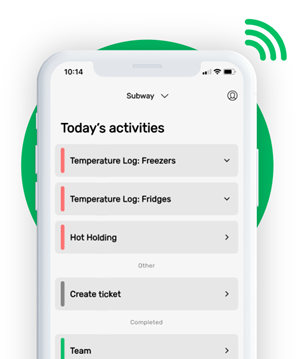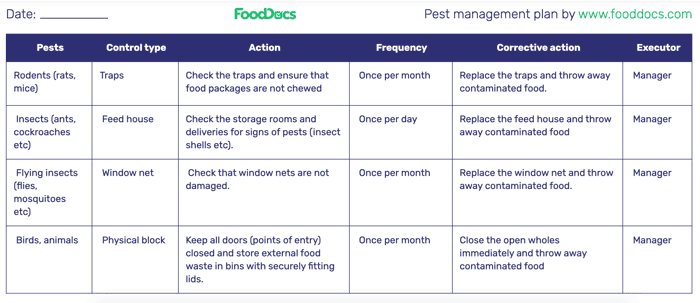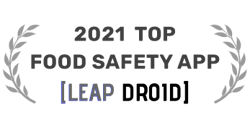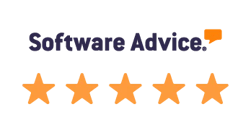PEST CONTROL TEMPLATE | FREE DOWNLOAD
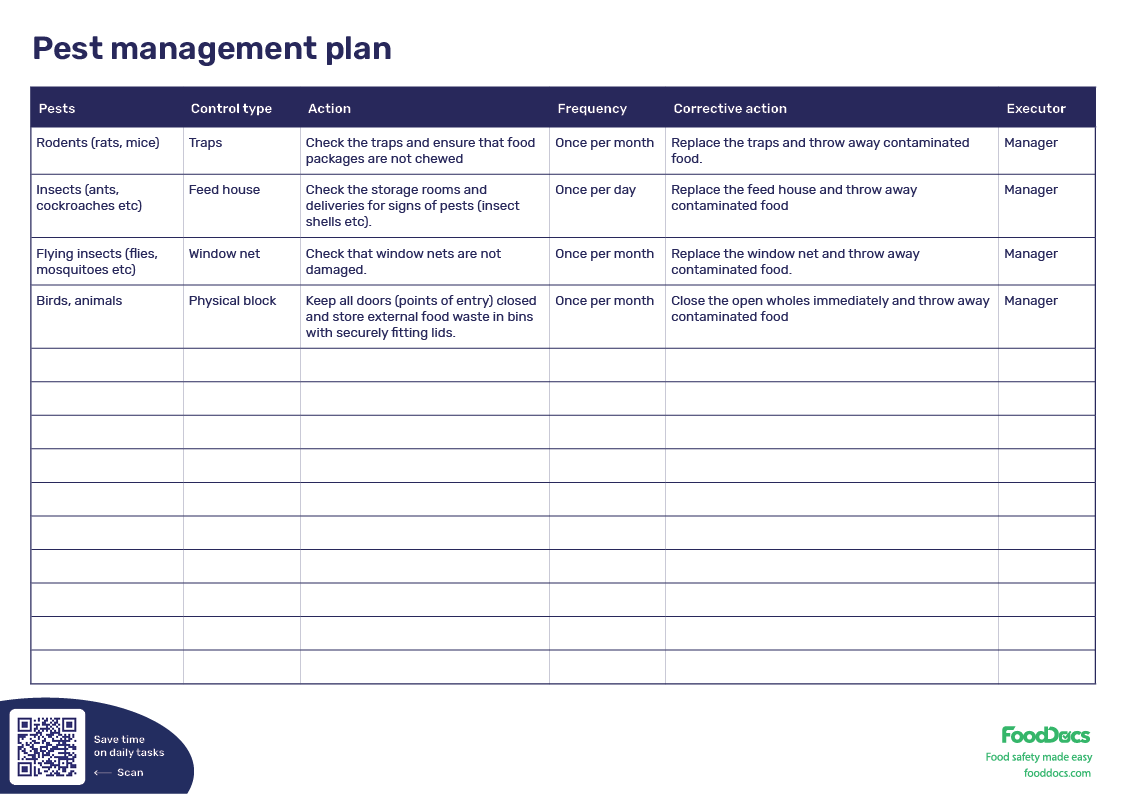

This is how our Digital Food Safety platform saves 20% of your time on daily tasks:
- Get upcoming task notifications
- Add data into the app
- Check the status of tasks in real-time

When food safety was still handled on paper, I typically spent a couple of hours per day getting the papers and going around checking or completing tasks… Now I can sit down and it's just all there in one place. It takes me 5-10 minutes.
Ruth B.
Store Manager
6 Steps to an Effective Pest Management Program
In food businesses, pest management is always a must. Pests can put your products and your business's reputation at risk because nobody wants to find something in the product that's not on the menu or get a foodborne illness. Special precautions must be taken to keep pest control treatments from threatening food safety.
To better control pests, you need to apply the principles of integrated pest management. Though the phrase sounds complicated, it's not complicated at all. Every food business owner needs to understand that pest management is a process, not a one-time event for pest inspection, and that relying only on chemical controls is never the best solution. A well-organized pest management plan can prevent an infestation before pesticides are even considered.
We have created a template of the Pest Management Program for you. Feel free to change it according to your needs and download it. A pest management plan is a summary and a result to a Pest Control chapter of your HACCP plan that involves a thorough analysis of the whole topic, ranging from how to get pests away from your food, to what the hazards are, and how you can prevent problems in the future.
Key takeaways
-
Pest management is a critical component of food safety, and effective pest control is essential to prevent contamination and foodborne illness.
-
A well-organized pest management plan can prevent infestations before pesticides are even considered and should be a key part of every food business's HACCP plan.
-
Identifying the root cause of a pest infestation is crucial to developing an effective control strategy, and region-specific pest management should be considered to address local pest populations.
-
Non-chemical control methods, such as traps, exclusion, and sanitation, can be an effective and sustainable way to manage pests, and should be considered as part of a comprehensive pest management program.
-
Employee training and accountability are critical components of an effective pest management program, and employees should be trained to identify pest activity and report infestations.
-
Regular inspections and monitoring are essential to detecting pest activity and preventing infestations, and should be conducted weekly or monthly depending on the facility's pest risk.
-
Documentation is a critical component of an effective pest management program, and records should be kept of pest activity, control methods, and inspections to ensure regulatory compliance.
-
Sanitation and hygiene practices are essential to preventing pest infestations, and SSOPs should be developed and implemented to ensure consistent sanitation and hygiene practices.
-
Technology and tools, such as food safety management software and sensors, can be used to streamline pest management and improve effectiveness, and should be considered as part of a comprehensive pest management program.
-
Regulatory requirements and compliance should be considered when developing a pest management program, and facilities should ensure they are meeting all relevant food safety regulations and standards, including HACCP and FDA regulations.
To get a customizable and pre-filled version instead, go to this pest control template.
STEP 1: PEST IDENTIFICATION
Different pests have different behaviors. By identifying the problematic species, pests can be eliminated more efficiently and with the least risk of harming other organisms.
All food business operators have the responsibility to control pests. This may be carried out by company staff (small businesses) or by local pest control companies. If carried out by staff, a pest management checklist template will help ensure that areas are not missed out from inspection and provide a place to record whether infestations have been found and the action that is then taken.
If using contractors, choose carefully. Ask for evidence of competence, for example, training certificates or references. Agree with the service that will be provided, reporting procedures, and record-keeping.
A specialist contractor can advise on suitable housekeeping measures to prevent pest infestation in restaurants.
Depending on the region, top pests in restaurants and commercial kitchens are:
Rodents - rats and mice
As a key player in the urban pest category, rodents such as rats and mice are one of the most common pests found infesting restaurants, cafes, commercial kitchens, and other foodservice businesses. They can also cause loss of stock by eating food items and damaging food containers and packaging. Additionally, they have also been known to spread a range of diseases such as Salmonellosis, which can contaminate food items and equipment through their urine and droppings.
Insects – ants and cockroaches
Cockroaches and ants are the most common type of crawling insects that infest restaurants. They cause particular problems because of their size, giving them the ability to hide in small places, their varied diet, rapid reproduction, and the diseases they can carry.
Flying insects – flies and mosquitoes
There are a number of species of flies, such as fruit flies, drain flies, and house flies, that are attracted to different food products However, they all pose the same risk to food safety. These small insects are known to transmit over 200 various pathogens, leading to the contamination of food items, machinery, and cooking utensils, posing a risk to both staff and customer health.
Birds and animals
Depending on the region, birds and animals can also be a physical threat. Usually, you can prevent them from causing problems with physical blocks.
Stored Product Insects
Stored Product Insects mostly infest products that have been already opened but can also enter packaging made of paper, cardboard, plastic, cellophane, and foil, chewing through the packaging material or crawling through folds and seams. These are also known to contaminate food products through physical damage, making food unfit or unacceptable for human consumption.
What are some key considerations during the pest identification step?
When it comes to pest management, it's essential to consider the regional pests that are most likely to infest your food business. Different regions have different pest profiles, and understanding these differences is crucial to developing an effective pest management program.
For example, in the southern United States, cockroaches and fire ants are common pests, while in the northern states, rodents and pigeons are more prevalent. In coastal areas, seagulls and other birds can be a significant problem, while in urban areas, pigeons and rats are often the primary pests.
To develop a region-specific pest management program, you'll need to research the common pests in your area and understand their habits, habitats, and behaviors. This will help you identify the most effective control methods and preventions for your specific region.
Some questions to consider when developing a region-specific pest management program include:
- What are the most common pests in my region?
- What are the typical habitats and behaviors of these pests?
- What are the most effective control methods for these pests?
- How can I prevent these pests from infesting my food business?
Considering these factors and developing a region-specific pest management program will help you reduce the risk of pest infestations and protect your food business from the potential risks associated with pests.
STEP 2: CONTROL TYPE
Depending on the pests, you need to choose the control type, how to keep the pests under control, and how to prevent them the most effectively. Here, it would be best if you also considered using non-chemical control methods. So, use the right treatments in the right places and only as much as you need to get the job done.
The most common control types are:
- Traps
- Feed houses
- Window nets
- Physical blocks
While chemical control methods can be effective in eliminating pests, they can also pose risks to human health and the environment. Non-chemical control methods, on the other hand, offer a safer and more sustainable alternative for managing pests.
Some examples of non-chemical control methods include:
- Traps: Using traps to capture and remove pests from your food business can be an effective way to control pest populations.
- Exclusion: Sealing entry points and denying pests access to your food business can prevent infestations from occurring in the first place.
- Sanitation: Keeping your food business clean and sanitized can help reduce the attractiveness of your facility to pests.
- Biological control: Using natural predators or parasites to control pest populations can be an effective and sustainable way to manage pests.
Non-chemical control methods can be used alone or in combination with chemical control methods to provide a comprehensive pest management program. Using non-chemical control methods helps to reduce the risks associated with chemical pesticides and create a safer and more sustainable food business.
STEP 3: PREVENTIVE ACTION
As pest control management is an ongoing process, constantly monitoring your facility for pest activity can protect against infestation and help eliminate existing ones.
Since your pest control professional most likely visits your facility monthly or weekly, your staff needs to be the daily eyes and ears of the pest management program.
Employees should be constant in cleaning and sanitation schedule that affect the program and report any pest activity signs. You don't want to lose a day when it comes to reacting to an actual pest presence.
The most popular preventive actions are:
- Checking traps and checking that food packages are not chewed
- Checking that there are no signs of insect activity (insect shells etc.)
- Checking that window nets are intact;
- Checking that the building does not have open holes and waste containers are closed
- A good cleaning schedule and cleaning checklist are always the best to prevent infestations and cleaning up all food and drink spillages
- Implementing a proper waste management plan
When it comes to employees, training and accountability are critical components of an effective pest management program. Employees play a key role in preventing pest infestations and detecting pest activity, and it's essential to provide them with the training and resources they need to do their job effectively.
Some ways to train and hold employees accountable for pest management include:
- Providing regular training sessions on pest management and prevention
- Encouraging employees to report pest sightings and activity
- Establishing clear protocols for responding to pest infestations
- Conducting regular inspections to ensure compliance with pest management protocols
Training and holding employees accountable for pest management will help ensure that your food business is taking a proactive and comprehensive approach to managing pests.
STEP 4: INSPECTION FREQUENCY
The most essential part of every effective pest management program is a scheduled frequency of regular pest control inspections. For food businesses, weekly inspections are common, and some production companies inspect even more frequently.
These routine inspections should focus on areas where pests are most likely to appear — receiving docks, storage areas, wardrobes, break rooms, and sites of recent ingredient spills — and identify any potential entry points, food, water sources, or harborage zones that might encourage pest problems.
What role does technology play in food safety inspections?
Technology and tools can play a significant role in streamlining pest management and improving the effectiveness of your pest management program. Some examples of technology and tools that can be used for pest management include:
- Pest management software: Using software to track and manage pest activity, schedule inspections, and document control methods can help you stay organized and ensure compliance with regulatory requirements.
- Food safety mobile apps: Using mobile apps to report pest sightings and activity, access pest management protocols, and receive notifications and alerts can help you respond quickly and effectively to pest infestations.
- Sensors and monitoring systems: Using sensors and monitoring systems to detect pest activity and track environmental conditions can help you identify potential pest problems before they become major infestations.
By leveraging food safety management software, you can improve the efficiency and effectiveness of your pest management program, reduce the risk of pest infestations, and protect your food business from the potential risks associated with pests.
STEP 5: CORRECTIVE ACTION
As regular pest control inspections reveal vulnerabilities in your pest management program, take steps to address them before they cause a real problem.
One of the most effective prevention measures is exclusion, i.e., performing structural maintenance to close potential entry points revealed during the inspection.
By physically keeping pests out, you can reduce the need for chemical countermeasures. Likewise, proper disinfection will eliminate potential food and water sources, thereby decreasing pest pressure.
While pest management is an essential component of food safety, it's not always easy to get it right. Some common mistakes that can be made in pest management include:
- Failing to identify the root cause of a pest infestation
- Using the wrong control methods or products
- Not following up after a pest infestation to ensure that the problem has been fully resolved
- Not documenting pest management activities and control methods
Some examples of corrective actions for pest management:
- In the case of rodents, if the package is chewed, it will be replaced with new bites. Chewed food is always thrown away.
- If insects are found, feed houses are replaced with new ones.
- If the window net is broken, it will be replaced with new ones.
- In the case of birds and animals. If possible and needed, open holes will be closed.
STEP 6: DOCUMENTATION
Let’s face it, the local authorities' visit can break your business. Your pest control plan has to be ready for the HACCP audit at any time. Up-to-date pest management documentation is one of the first signs to authorities that your facility takes pest control seriously.
Pest management is not just about protecting your food business from the risks associated with pests - it's also about complying with regulatory requirements and ensuring that your business is meeting the necessary standards for food safety.
Some of the key regulatory requirements and standards that apply to pest management in food businesses include:
- HACCP (Hazard Analysis and Critical Control Points) protocols
- FDA regulations and guidelines
- Local and state laws and regulations
Understanding these regulatory requirements and standards, and taking steps to ensure compliance, will enable you to better protect your food business from the risks associated with pests, and ensure that your business is operating safely and responsibly.
Key pest management documents include:
- Pest Management Plan. Feel free to use the template above.
- Pest control chapter with hazard analyses in your HACCP plan.
- Pest management inspection checklist.
- Trap layout maps that are a part of your HACCP plan.
If you need any other templates for your HACCP plan, find them in our food safety templates hub.
How to make pest management easy with food safety software
At FoodDocs, we can help you quickly and easily digitize your pest management monitoring tasks so you're always ready for health inspections.
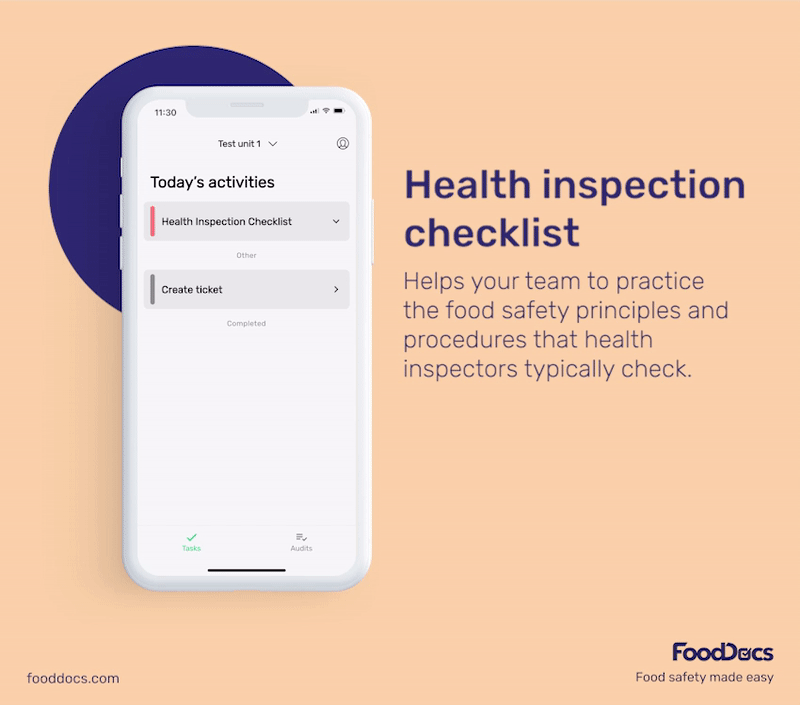
If you don't have an HACCP plan, FoodDocs can create your pest control plan and maintain compliance with pest control regulations that includes the following sections:
- Potential hazard description
- Preventive measures
- Corrective action
- Appropriate monitoring procedures
And the following components:
- Basic flowchart of your operations
- Hazard analysis
- Established critical control points (CCP) with critical limits
- Established monitoring procedures
- Corrective action plan
- Verification procedures
- Recordkeeping and documentation procedures
What used to be a month-long process of making a HACCP plan can now be done in just 1 hour using our customizable HACCP plan template builder. Our digital solution is 500x faster than hiring a food safety consultant to help you build a paper-based HACCP plan.
